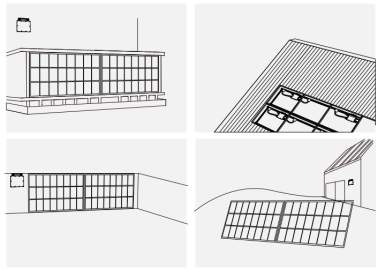Introduction
Enter the all-in-one solar power system—a comprehensive solution that integrates all essential components into a single, streamlined unit. This innovative approach simplifies the installation process, enhances system efficiency, and provides a cost-effective way to harness solar energy. An all-in-one solar power system includes solar panels, an MPPT charge controller, an inverter, and battery storage, all coordinated by an integrated management system to ensure optimal performance.
Understanding All-in-One Solar Power Systems
Definition and Components
An all-in-one solar power system integrates all essential components into a single unit for seamless energy production, conversion, and storage.
These components include:
|
Solar Panels |
Capture sunlight and convert it into DC electricity. |
|
MPPT Solar Charge Controller |
Optimizes energy harvest by ensuring solar panels operate at their maximum power point. |
|
Inverter |
Converts DC electricity to AC for home use. |
|
Battery Storage |
Stores excess energy for later use. |
|
Coordinates all components for optimal performance. |
The primary benefit of all-in-one solar power systems is their integrated design, which simplifies installation and maintenance. This integration ensures compatibility and maximizes efficiency, offering a user-friendly and reliable solution for harnessing solar energy.
Cost-Effectiveness of All-in-One Solar Power Systems
Initial Investment vs. Long-Term Savings
While the initial investment in an all-in-one solar power system might be substantial, it is offset by significant long-term savings. These systems are designed for high efficiency and durability, ensuring a steady reduction in electricity costs over time. The upfront cost includes everything needed for installation and operation, minimizing the risk of unexpected expenses down the line.
Reduction in Energy Bills
One of the most immediate benefits of installing an all-in-one solar power system is the reduction in monthly energy bills. By generating your own electricity, you can significantly decrease or even eliminate your reliance on the grid, leading to substantial savings. Excess energy produced can be stored in batteries or fed back into the grid, further offsetting costs through net metering or feed-in tariffs.
Lower Installation and Maintenance Costs
All-in-one solar power systems are designed for ease of installation, reducing labor costs and installation time. Unlike traditional systems that require complex wiring and multiple installers, these integrated systems come pre-configured, simplifying the setup process. Maintenance is also more straightforward and less frequent, as all components are designed to work together seamlessly, reducing the likelihood of malfunctions and the need for repairs.
Ease of Installation and Maintenance
Streamlined Installation Process
All-in-one solar power systems offer a streamlined installation process. With all essential components integrated into a single unit, these systems require fewer connections and less wiring compared to traditional setups. This not only reduces the time and labor needed for installation but also simplifies the overall process, making it more accessible for both professional installers and DIY enthusiasts.
Minimal Maintenance Requirements
Maintenance for all-in-one solar power systems is minimal due to their integrated design. Regular cleaning of the solar panels and occasional system checks are usually sufficient to keep the system running efficiently. The fewer individual components mean there are fewer points of potential failure, reducing the need for frequent maintenance and repairs. Additionally, the integrated management system continuously monitors the performance of the entire setup, alerting homeowners to any issues that may arise.
Environmental Benefits
Reduced Carbon Footprint
All-in-one solar power systems significantly reduce your carbon footprint by harnessing clean, renewable energy from the sun. Unlike fossil fuels, solar energy does not produce greenhouse gases or other pollutants during operation. By switching to solar power, homeowners and businesses can decrease their reliance on carbon-intensive energy sources, contributing to a healthier planet.
Contribution to Sustainability Goals
Installing an all-in-one solar power system supports broader sustainability goals by promoting energy independence and reducing the demand for non-renewable resources. As governments and organizations worldwide set ambitious targets for reducing carbon emissions and increasing the use of renewable energy, adopting solar power helps meet these objectives. Individuals and businesses using solar power can also align with corporate social responsibility (CSR) initiatives and showcase their commitment to environmental stewardship.
Positive Impact on the Environment
The environmental benefits of solar power extend beyond reducing carbon emissions. Solar energy production does not require water, unlike traditional power plants that consume vast amounts of water for cooling. Additionally, solar power systems generate electricity without producing air pollutants or hazardous waste, contributing to cleaner air and water. By reducing the strain on natural resources and minimizing ecological disruption, solar power promotes a more sustainable and resilient environment.

Scalability and Future-Proofing
Ability to Expand the System as Needed
One of the significant advantages of all-in-one solar power systems is their scalability. These systems are designed to be easily expandable, allowing you to increase your energy capacity as your needs grow. Whether you start with a small setup and expand over time or plan for future additions from the beginning, all-in-one systems can accommodate these changes without requiring a complete overhaul of your existing infrastructure.
Integration with Smart Home Technologies
All-in-one solar power systems are increasingly compatible with smart home technologies, offering enhanced control and efficiency. Integration with smart thermostats, energy management systems, and other IoT devices allows for real-time monitoring and optimization of energy usage. This seamless integration not only enhances convenience but also maximizes the overall efficiency of your energy consumption, adapting to your lifestyle and usage patterns.
Preparing for Future Energy Needs
Investing in an all-in-one solar power system helps future-proof your energy setup. As energy demands evolve with the addition of new appliances, electric vehicles, or changes in household size, your solar system can be easily adjusted to meet these needs. Moreover, advancements in solar technology and energy storage solutions can be incorporated into your existing system, ensuring that you stay current with the latest innovations and continue to benefit from improved efficiency and performance.


